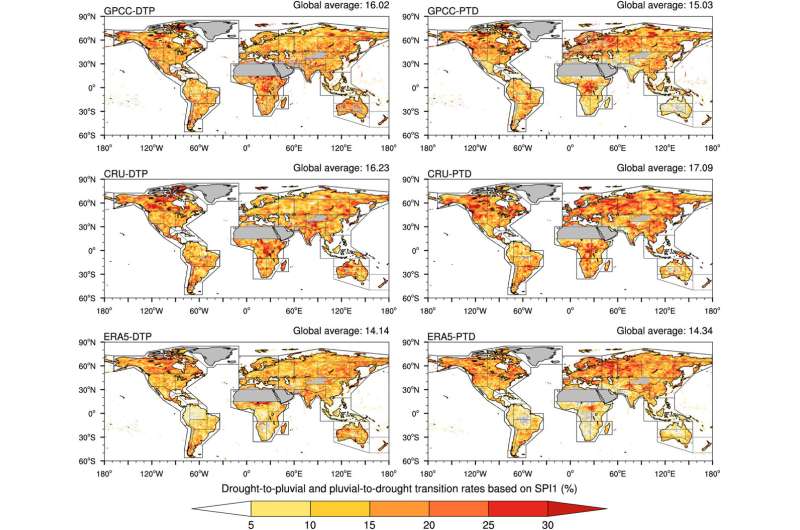This article has been reviewed according to Science X's editorial process and policies. Editors have highlighted the following attributes while ensuring the content's credibility:
fact-checked
peer-reviewed publication
trusted source
proofread
New research provides a clearer picture of severe hydro hazards

Over the last two decades an estimated three billion people have been affected by water-related natural disasters such as droughts and floods. Climate change is expected to increase the frequency of these hydro hazards, with some prognosticators estimating there will be upwards of $3.7 trillion in water-related damage over the next 30 years in the U.S. alone. Beyond damaging homes and infrastructure, severe wet and dry spells will also devastate crops and deplete water reservoirs.
An increasing area of interest to researchers is the frequency of compound drought and pluvial flooding (caused by quick, heavy rainfall or sustained rainfall beyond the norm), which is when both occur in succession in the same area within a year of each other. Historically, this level of coincidence has been under-examined.
Of similar interest is when the reverse happens: extreme rainfall followed by a meteorological drought. Meteorological drought is when dry weather patterns prevail, which can eventually trigger hydrological drought, leading to dry streams and plunging reservoir levels, such as what happened at Lake Mead in 2022.
A new study co-authored by researchers in the University of Arkansas Department of Geosciences, as well as colleagues in China, now provides a global examination of drought-pluvial volatility—or the tendency to shift from one extreme to another (from dry to wet or wet to dry) in a short period of time.
Yichan Li, a Ph.D. candidate at the U of A, was the first of four authors on the paper, "Observational Uncertainty for Global Drought-Pluvial Volatility," published in Water Resources Research, while Linyin Cheng, an assistant professor of geosciences, was second author.
The study looks at extreme dry-to-wet and wet-to-dry transitions over the past seven decades through event coincidence analysis, a method of quantifying the number of consecutive extreme events that also considers instantaneous or lagged responses within an uncertain period between them. The study used three widely-used climate data sets to provide evidence of increased drought-pluvial volatility on time scales of less than a year.
The team also evaluated the accuracy of these data sets, finding varying strengths and weaknesses of each due to observational uncertainties in data collection. For instance, the remoteness of a region may play a role in collecting accurate data.
Averaged out at the global scale, the team found that 15.46% of all meteorological droughts were succeeded by a pluvial the following season. The wet-to-dry transition percentage proved remarkably similar: 15.49%. However, prominent differences exist when looking at particular regions.
Toward that end, the study provides a map demonstrating how incidents of these two phenomena are distributed globally. Overall, the spatial pattern of extreme dry-to-wet and wet-to-dry events' coincidence rates is largely in agreement among the three data sets, though there is prominent regional variability.
For instance, in Eurasia since the mid-20th century, there is a relatively low probability for meteorological droughts transitioning to pluvials, but a higher chance for the opposite scenario, rapid shifts from wet to dry events.
A similar pattern also exists over western North America, which sees severe wet to dry transitions at a frequency greater than 17% on average. Conversely, South Asia and Australia are more prone to immediate transitions from meteorological droughts to pluvials.
The authors noted, "Our findings indicate that differences associated with drought-pluvial volatility among the considered observations are in many regions larger than that of their single events [droughts or pluvials alone], highlighting a need of to use multiple independent observation-based data sets for more robust examinations when studying such compound extreme events."
Ultimately, the authors stress the need to use multiple independent observation-based data sets when analyzing extreme, compound dry-to-wet events. This will provide clearer guidelines for climate-related decision making, especially water resources planning, as well as ensure better accuracy when modeling future weather events.
More information: Yichan Li et al, Observational Uncertainty for Global Drought‐Pluvial Volatility, Water Resources Research (2023). DOI: 10.1029/2022WR034263
Journal information: Water Resources Research
Provided by University of Arkansas





















